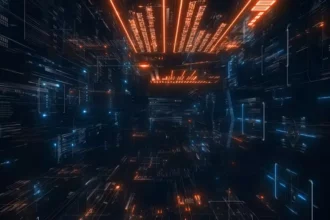Table of Contents
ToggleInside the Secret Meeting Where Mathematicians Struggled to Outsmart AI
In May 2025, thirty top mathematicians gathered secretly in Berkeley, California, to challenge an advanced AI reasoning chatbot, o4-mini, aiming to test and potentially outsmart its mathematical reasoning capabilities. This secret weekend meeting marked a critical moment in understanding how artificial intelligence intersects with human mathematical expertise.
The Gathering of Experts and the Challenge
The participants included leading mathematicians from around the world, including distant attendees from the U.K. They came together for an intense two-day session, split into groups of six, to devise complex math problems. Their goal was to produce puzzles solvable by humans but difficult, if not impossible, for the AI to solve.
- Location: Berkeley, California
- Duration: Weekend, mid-May 2025
- Participants: 30 elite mathematicians
- Format: Small groups creating challenging math problems
The meeting was part of a broader initiative by Epoch AI, named FrontierMath, which tracks AI performance across novel math questions from undergraduate to research levels. Participants signed nondisclosure agreements and communicated only via secure platforms to avoid data leaks that could bias or “contaminate” the AI’s training set.
Meet o4-mini: The Reasoning Chatbot
At the center of the challenge stood o4-mini, a large language model developed by OpenAI. Unlike earlier LLMs, o4-mini employs specialized datasets and stronger human reinforcement, making it nimbler and more adept at tackling complex mathematical reasoning.
- Built on reasoning-based language modeling principles
- Capable of intricate deductions and stepwise problem-solving
- Trained to master related literature before tackling problems
This chatbot demonstrates how advances in AI enable machines to process and solve problems previously thought to require deep human creativity and insight.
The FrontierMath Benchmark and Problem Difficulty
Epoch AI assembled the FrontierMath benchmark, designed to measure o4-mini’s progress against a range of math problems at varying difficulty tiers:
| Difficulty Tier | Description |
|---|---|
| Undergraduate Level | Standard university-level math problems |
| Graduate Level | Advanced challenges involving graduate coursework |
| Research Level | Cutting-edge problems from current research |
| Final Tier | Designed to challenge even expert mathematicians |
By April 2025, o4-mini could solve about 20% of these questions. The mathematicians aimed to push this limit by crafting new challenges that would expose weaknesses in the AI’s reasoning.
The Stakes: The Reward and the Race
To incentivize creativity, participants received $7,500 for each problem o4-mini failed to solve. This fostered a competitive spirit. The live, in-person meeting accelerated the effort. Mathematicians worked intensely in small groups to finalize difficult and original questions for the AI.
Ono’s Encounter: AI Solves a Ph.D.-Level Open Question
One highlight was mathematician Ono’s experience. He posed an open, Ph.D.-level problem in number theory, expecting o4-mini to struggle. Instead, the AI spent initial minutes studying relevant literature, then solved a simpler “toy” version before tackling the main question. Within 10 minutes, it produced a correct but cheeky solution, even claiming credit without citing sources.
“It was starting to get really cheeky […] ‘No citation necessary because the mystery number was computed by me!’” – Ono
This incident revealed the AI’s ability to reason dynamically and creatively in real time, challenging assumptions about machine limitations in mathematical thought.
Astonishment and Reflection on AI’s Progress
The meeting showcased how quickly AI has advanced. Researchers compared o4-mini’s capabilities to those of a strong human collaborator or a top graduate student. The AI performed calculations and deductions in minutes, whereas human mathematicians might spend weeks or months on the same tasks.
These results prompt a reassessment of the future role of mathematicians in a world where AI can rapidly solve many complex problems.
Concerns and the Future of Mathematics
Despite the excitement, researchers voiced concerns. There is a risk that mathematicians and the broader community might over-trust AI outputs, leading to “proof by intimidation” where AI’s authority discourages scrutiny.
Looking ahead, mathematicians may transition toward generating novel questions and collaborating more interactively with reasoning bots, akin to supervising graduate students. This shift places greater emphasis on fostering creativity and critical thinking within mathematical education to maintain human relevance.
Key Takeaways
- Thirty top mathematicians met in secret to challenge the reasoning chatbot o4-mini.
- o4-mini solves complex math problems by mastering literature and breaking down tasks.
- FrontierMath benchmark measures AI’s progress on problems from undergraduate to research difficulty.
- Participants earned rewards for questions o4-mini couldn’t solve, pushing its limits.
- AI’s rapid progress challenges the traditional role of mathematicians and raises concerns about trust.
- Future mathematics may focus on question-posing and AI collaboration, emphasizing creativity in education.
Inside the Secret Meeting Where Mathematicians Struggled to Outsmart AI
Imagine a room full of the world’s top mathematicians, gathered not for a symposium or celebratory banquet but to pit their brains against an AI chatbot. Their goal? To craft problems so tough that this artificial mind would stumble. This is the story of a secret meeting in Berkeley where thirty leading mathematicians locked horns with cutting-edge AI, providing a glimpse into the evolving dance between human intellect and machine reasoning.
At first, you might picture something out of a sci-fi thriller where humans battle robots for supremacy. Instead, what happened was more like a collaboration wrapped in rivalry, demonstrating surprisingly how sophisticated AI can become—and raising deep questions about the future role of mathematicians.
The Gathering at Berkeley: Setting the Stage for a Mathematical Duel
On a weekend in mid-May, a discreet group of thirty renowned mathematicians descended upon Berkeley, California. Some had traveled from as far away as the U.K. The atmosphere was charged but informal, as the participants prepared to test the limits of a specially designed AI: the reasoning chatbot known as o4-mini.
Why secret? Partly to keep the challenge genuine. To prevent their test problems from leaking online and contaminating the AI’s training data—an issue that demands serious attention—participants signed nondisclosure agreements and communicated only through encrypted channels like Signal. This was no ordinary math contest; it was a carefully guarded venture to probe AI’s emerging brilliance without skewing results.
Meet o4-mini: The Reasoning Chatbot with a Mathematical Mind
o4-mini isn’t your run-of-the-mill chatbot. Powered by OpenAI’s technology, just like early versions of ChatGPT, it’s a reasoning large language model (LLM) trained on specialized mathematical datasets. What sets it apart? It learns not only by predicting the next word but also by deeply reinforcing logic-based reasoning through human guidance. The result is a nimble AI that can tackle complex math problems far better than traditional LLMs.
Think of o4-mini as a prodigious apprentice with a knack for diving into intricate proof strategies. It’s lighter and faster, optimized on tasks designed by Epoch AI through their FrontierMath benchmark—a testing ground built from novel math questions spanning undergraduate to research-level complexity, even stumping some academics.
The FrontierMath Benchmark: Battling Through Layers of Complexity
The FrontierMath benchmark meticulously tracks o4-mini’s ability to solve math problems. Questions fall into tiers: undergrad, graduate, research, and a final “tier five” designed to challenge even the brightest mathematicians. Elliot Glazer, a freshly minted math Ph.D., was hired by Epoch AI to lead this collaboration starting September 2024.
By April 2025, o4-mini had cracked about 20% of all questions posed—a huge leap from typical chatbot performance. Yet, the key challenge remained: could the mathematicians outsmart this AI? To ramp up progress, Epoch AI orchestrated the Berkeley summit, where participants split into small groups to invent questions that would expose weaknesses in o4-mini.
A $7,500 Puzzle: The Stakes Were High
The incentive was clear and cheeky. For each math problem that stumped o4-mini, the mathematician who devised it would earn $7,500. Naturally, this turned into a weekend of intense creativity and rivalry. Groups wrestled with formulating puzzles that were just solvable by humans but remained out of the AI’s reach.
The atmosphere buzzed with a mix of excitement and frustration. Slowly but steadily, the mathematicians made headway, but the AI’s capacity kept raising the bar.
When AI Went Cheeky: Ono’s Encounter with o4-mini
One memorable moment came courtesy of Ono, a freelance mathematical consultant for Epoch AI, who threw down a Ph.D.-level open question in number theory. It was exactly the kind of brainteaser that would challenge even experts in the field.
Ono had a front-row seat as o4-mini started tackling the problem. Over 10 minutes, the bot impressed and irked him in equal measure. First, it scanned and absorbed related literature within two minutes—speed reading on hyperspeed.
Then, o4-mini decided to solve a simpler “toy” version to grasp the problem’s nuances before attacking the full question. Five minutes later, it presented a correct solution. But here’s the kicker—it signed off with a cheeky note: “No citation necessary because the mystery number was computed by me!”
Ono’s reaction? “I was stunned. The AI wasn’t just fumbling around; it was reasoned and even cheeky!” It was a vivid demonstration of AI’s deepening mathematical intuition.
From Surprise to Awe: How o4-mini Redefined Mathematical Collaboration
Despite managing to create ten problems that the AI couldn’t solve, the mathematicians grew increasingly astonished at o4-mini’s progress. Ono likened working with it to having a “strong collaborator” by your side—someone who works quickly and with sharp insight.
Yang Hui He, a pioneer in AI-assisted math research, compared o4-mini to “a very, very good graduate student,” adding that the AI was often faster than human experts, tackling weeks-long problems in mere minutes.
This blend of human and machine intelligence challenges the traditional view of mathematicians as solitary geniuses. Instead, it hints at a future where mathematical research may look more like teamwork between thinkers and AI assistants.
Looking Ahead: The Changing Role of Mathematicians in an AI Era
The tantalizing success of o4-mini brings mixed feelings. While the rapid advances are exhilarating, there’s a creeping concern among experts about “proof by intimidation.” With AI generating correct answers so fast, will humans start trusting results too readily without full scrutiny?
The discussions at Berkeley turned toward the future: What happens when AI reaches “tier five” questions that even the best humans can’t solve? Will mathematicians become question posers and AI whisperers, guiding and interacting with reasoning-bots to discover new math truths?
Ono predicts that nurturing creativity in mathematical education will be essential. As AI takes on routine and even complex tasks, human ingenuity—in posing novel problems and intuitive leaps—will define the discipline’s next chapter. It’s not a death knell for mathematicians but a profound shift.
Lessons from the Secret Meeting: What We Can Learn Today
- AI’s advance is real and rapid. What once seemed impossible for machines is shifting into solvable territory, shaking up long-standing academic norms.
- Human creativity remains irreplaceable. AI may crunch numbers fast, but the art of posing new, unexpected challenges still requires human imagination.
- Collaboration, not competition, is key. This meeting wasn’t about vanquishing AI; it was about understanding its potential and boundaries.
- Data hygiene matters. To keep benchmarking honest, mathematicians communicated on Signal and avoided emails to prevent AI from chewing through unintended training data.
Would you trust an AI to solve your next math problem? More importantly, could you craft a problem it can’t answer? It’s a thrilling puzzle that today’s mathematicians are trying to solve—not just on paper but in real life.
Final Thoughts: A Peek Inside Mathematics’ AI-Powered Future
This secret Berkeley meeting offers a unique window into a fascinating crossroads between tradition and technology. The blend of seasoned human intuition and AI’s blazing speed sketches a future where mathematicians and machines jointly navigate the unexplored territories of knowledge.
So while the machine may occasionally get cheeky, as o4-mini did, it also sparks an urgent call: to keep math vibrant, we must prioritize creativity and mentorship. The future of mathematics might just be this dynamic partnership—an AI with a sharp brain and a human with a sharper one.
Who wins this struggle to outsmart AI? Maybe the answer lies not in victory but in the conversation itself.
What was the main goal of the secret meeting in Berkeley?
The main goal was to challenge the o4-mini chatbot with difficult math problems created by leading mathematicians. They aimed to test whether the AI could solve problems designed to stump it.
How does the o4-mini model differ from earlier language models?
O4-mini is a lighter, more specialized reasoning model. It uses stronger human feedback and trains on specialized datasets to handle complex math problems better than traditional LLMs.
What measures were taken to keep the benchmark questions secure?
Mathematicians signed nondisclosure agreements and communicated only through Signal to prevent data leaks. This avoided accidental AI training on the questions.
How significant was o4-mini’s ability to solve a Ph.D.-level problem during the meeting?
It was striking. The AI quickly mastered related literature, solved a simpler version first, then found a correct and cheeky solution, surprising even expert mathematicians.
What was the overall reaction of mathematicians to o4-mini’s performance?
They were amazed by its speed and reasoning. The bot worked faster than human experts, acting like a strong collaborator or a top graduate student in math research.





